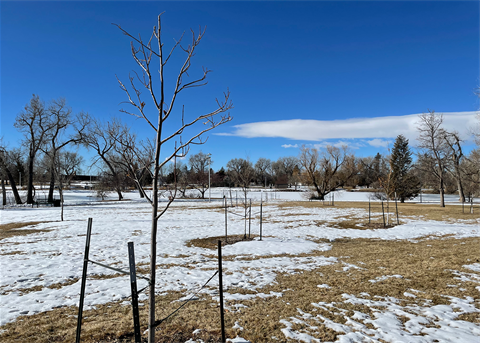Urban Forestry outlines state of tree canopy; 2024 goals
Published on February 15, 2024

City residents may have noticed the removal of a number of large trees this winter at city parks, and while the loss of those trees may be painful to see, it represents the work of the Cheyenne Urban Forestry Division to maintain and build a healthy tree canopy in Cheyenne.
And although some trees are being removed, many more are being planted to take their place.
For the winter of 2023-24, Urban Forestry is in the process of removing a few dozen trees on city-owned properties: 15 at Holliday Park (4 complete); 16 at Lakeview Cemetery (13 complete); 6 at Youth Alternatives (5 complete); 8 at the Junior League (6 complete); and one at each Jaycee Park and Lake Absarraca.
The bulk of the tree removals are cottonwood and spruce, which are the two most common tree species in Cheyenne. In the case of cottonwood, the high rate of removals is due to old age and in some cases is being exacerbated by squirrel feeding. Many of Cheyenne’s oldest cottonwood trees were planted in the early 1900s and, with a lifespan of about 100-120 years, are dying and becoming hazardous.
The spruce canopy in town has also been experiencing high rates of mortality due to several factors, including climate change, bark beetle attack, and recycled water. Spruce is less drought tolerant than other conifers and without supplemental water, spruce become stressed as our climate becomes drier. In addition, the use of recycled water at larger city properties (sometimes known as “purple pipes”) has contributed to spruce decline. While recycled water is an important component of water conservation, certain tree species, like spruce, are less tolerant of recycled water. These combined factors have led to a large proportion of the city’s spruce canopy being unhealthy and highly susceptible to bark beetle attack.
“Cheyenne is losing tree canopy faster than any time in our history,” said Mark Ellison, the manager of Cheyenne Urban Forestry. “Over the past few years, we’ve averaged 134 large tree removals a year on City property, but prior to 2020, we only averaged about 40 large tree removals per year.”
Fortunately, Urban Forestry is actively planning for the future by maintaining the health of existing trees and overseeing the planting of a variety of new trees.
For example, although the City has seen an average of 134 large tree removals on City property per year in recent years, Urban Forestry has planted an average of 350 trees per year and can expand its planting capacity depending on funding. In all, Urban Forestry maintains about 15,000 trees on city property.
Rooted in Cheyenne, a program affiliated with Urban Forestry, is also increasing tree plantings, going from around 200 trees per year from 2018 through 2022 to 260 in 2023 and 300 in 2024. Of those trees scheduled to be planted this year, 100 will be free street trees to neighborhoods with low tree canopies.
This spring’s Rooted in Cheyenne’s free tree neighborhoods are Sun Valley, Saddle Ridge, Dakota Crossing, and JL Ranch. Free street trees are also available to other property owners meeting income requirements. Focus neighborhoods change annually.
To learn more about Rooted in Cheyenne, visit www.rootedincheyenne.com.
To learn more about Cheyenne Urban Forestry, visit www.cheyennetrees.com.